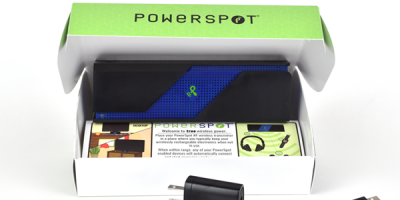Wireless transmitter charges multiple devices
Claimed to be the first transmitter that works at up to 80 feet (24.3m), charging multiple consumer devices over the air, the PowerSpot transmitter is now shipping from Powercast. The 3.0W Bluetooth-approved PowerSpot transmitter eliminates charging mats, using Powercast’s patented, remote wireless charging technology.
The transmitter creates a coverage area similar to Wi-Fi. It automatically powers or charges PowerSpot-enabled devices when they come within range. The transmitter uses the 915MHz ISM band to send RF energy over the air to Powercast’s tiny Powerharvester receiver chip embedded in a device, which converts it to DC to either directly power or recharge that device’s batteries. The Bluetooth-approved transmitter detects devices within range and automatically begins delivering power.
The PowerSpot transmitter was designed to automatically top off up to 30 PowerSpot-enabled devices left on a countertop overnight in its charging zone, which varies with device type and power consumption. Instructions included with enabled devices will show recommended charging distance and time for that device. For example, power-hungry, heavily used devices like game controllers, smart watches, fitness bands, hearing aids, or headsets charge best up to two feet (0.6m) away; keyboards and mice up to six feet (1.8m) away; smart cards and TV remotes up to 10 feet (3.0m) away; and low-power devices like home automation sensors up to 80 feet (24.3m) away. On the transmitter, an illuminated LED indicates devices are charging. Audible or visual alerts indicate when devices move in and out of the charge zone.
The Bluetooth-approved PowerSpot features a Bluetooth Low Energy (BLE) multiprotocol technology, with BLE wirelessly scheduling power transmissions, monitoring battery status of charging devices, turning off the transmitter when devices are fully charged, and communicating data (detected devices and their IDs, BLE signal strength, charging level, and more) to the PowerSpot app.
In Q4, the company will begin shipping a PowerSpot development kit (pictured). This enables engineers to test the PowerSpot’s capability to charge devices using multiple battery types. It includes the PowerSpot TX91503 transmitter, a development board able to charge three kinds of batteries (a Li-ion 2032 coin cell battery, a Li-Mn single AA, and 3 Ni-MH AAAs in series), two Powerharvester receiving antennae (patch and dipole), and two PS915 illuminated RF field detectors. The development board communicates with the PowerSpot via BLE to turn it on and off, and communicates key data to the development kit’s Powercast Charging Monitor app. The board also includes an LED indicator that demonstrates how distance from the transmitter impacts charging rate.
The PowerSpot transmitter is approved to FCC (ID: YESTX91503) and ISED (Canada IC: 8985A-TX91503). The company is also launching a development kit to help manufacturers easily design PowerSpot-based wireless charging ecosystems.




